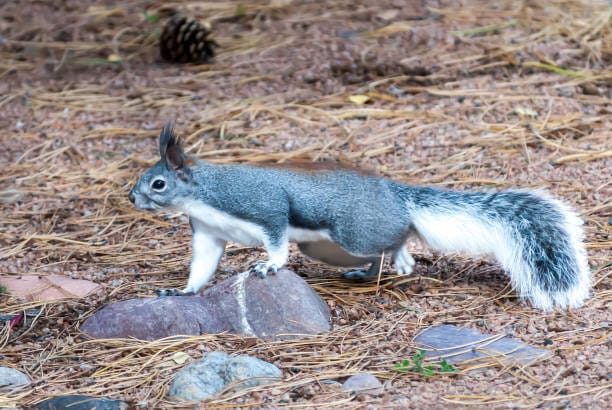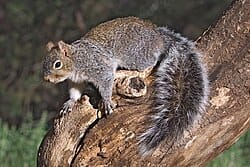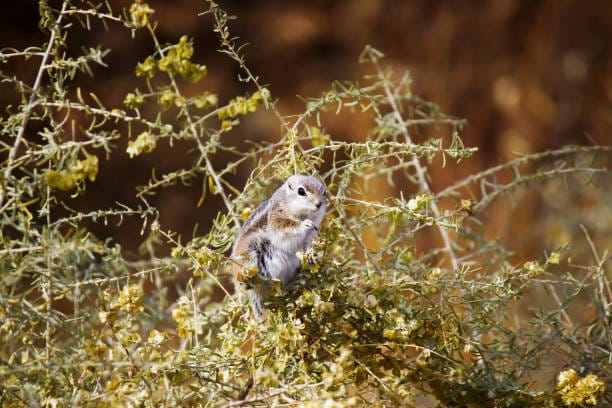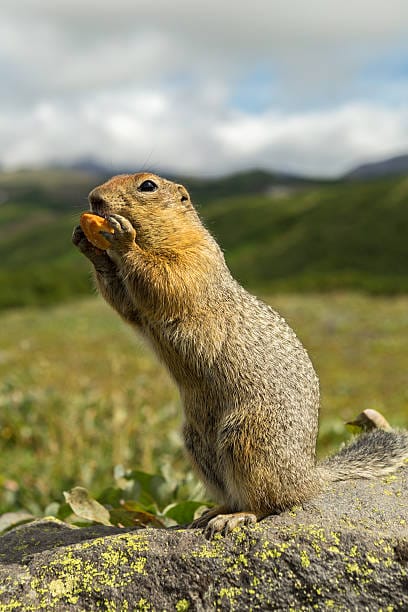Types of squirrels in Arizona are far more varied than most people think. From the mountain-loving Abert’s squirrel to the desert-dwelling ground species, Arizona’s mix of forests, canyons, and deserts offers homes for an incredible range of these busy creatures. In this guide, we’ll explore each species, how to identify them, and what makes them such fascinating parts of the state’s ecosystem. Whether you’re a hiker, photographer, or backyard wildlife watcher, knowing your local squirrels in Arizona will help you see nature in a whole new way.
1. Abert’s Squirrel (Sciurus aberti)

Physical Characteristics & Identification Tips
Abert’s squirrel is a true showstopper of the pine forests. Known for its dramatic ear tufts that stick up like little feather plumes, this species looks almost cartoonish — especially in winter when those tufts are longest. Adults average about 18 to 23 inches long including their tail, with gray bodies, white bellies, and a fluffy tail that sometimes has black tips. Their fur can vary slightly depending on region and season — a perfect example of nature’s way of blending style and survival.
- Length: 18–23 inches (including tail)
- Weight: 1.5–3 pounds
- Distinctive trait: Long ear tufts and a silvery-gray coat
Behavior
These squirrels are diurnal — meaning they’re active during the day — and spend most of their time climbing ponderosa pines. They are acrobatic jumpers, using their tails for balance as they leap from branch to branch. Abert’s squirrels are also vocal, producing a mix of barks and chirps that sound like a cross between a bird call and a squeaky toy.
Habitat and Range
You’ll mainly find Abert’s squirrels in the ponderosa pine forests of northern and central Arizona, particularly near Flagstaff, Sedona, and the Mogollon Rim. They depend heavily on pine ecosystems — the trees provide both food and shelter. Their nests, called dreys, are built high in the branches, where they can stay safe from predators like hawks and bobcats.
Diet
Abert’s squirrels have a diet closely tied to their favorite tree. They feed primarily on ponderosa pine seeds, inner bark, buds, and even fungi growing around tree roots. Occasionally, they’ll gnaw on pine cones so fiercely you can hear them echo through the woods. When food is scarce, they might even strip pine bark — leaving behind telltale patches on trunks.
Reproduction and Life Cycle
Breeding season usually begins in late winter, with litters born in early spring. A mother squirrel raises two to four babies in a leafy nest, and by summer the young are already climbing and foraging on their own. In the wild, they typically live around 6–7 years, though predators and harsh winters can shorten that span.
Fun Facts
- Sometimes called the “tassel-eared squirrel.”
- They often reuse the same nest for several years.
- They play a role in forest health by spreading fungal spores that help trees absorb nutrients.
Human Interaction
Abert’s squirrels are generally shy but can become surprisingly tolerant of human presence in forested towns. If you’re camping or hiking in pine country, you might catch one watching you from a branch. Please resist feeding them — they’re much better off gathering pine seeds the old-fashioned way.
2. Arizona Gray Squirrel (Sciurus arizonensis)

Physical Characteristics & Identification Tips
The Arizona gray squirrel is one of the state’s most elegant native species. With its sleek silver-gray fur, white underside, and large bushy tail, it’s easy to confuse with the eastern gray squirrel found elsewhere in the U.S. — but this one is truly Arizona’s own. They measure about 17–20 inches from head to tail and have rounder heads with soft brown highlights along their backs.
- Average length: 17–20 inches
- Tail: Full and bushy, often the same length as body
- Color: Silver-gray with subtle brown hues
Behavior
Arizona gray squirrels are tree-dwellers through and through. They are cautious, alert animals that use their keen eyesight and quick reflexes to dodge predators. They spend mornings and evenings foraging and rest during the hottest parts of the day. During summer, they can sometimes be seen flattening their bodies against cool tree branches to escape the desert heat — an adorable yet practical behavior called “splooting.”
Habitat and Range
This species inhabits riparian woodlands and mixed oak-pine forests, primarily in southeastern Arizona, including the Huachuca and Santa Catalina Mountains. They prefer areas near running water — a rare sight in desert landscapes — which makes spotting them a special treat for hikers.
Diet
They dine on nuts, seeds, fruits, buds, and the occasional mushroom. In autumn, they hoard acorns and pine seeds, burying them in caches that help them survive leaner months. Inadvertently, their habit of forgetting some of these caches helps replant future forests — proving even squirrels can be accidental conservationists.
Reproduction and Life Cycle
Arizona gray squirrels typically mate once a year, producing litters of two to four young. The babies are born blind and hairless but grow quickly under the mother’s attentive care. By 10 weeks, they’re ready to venture out, and by late summer, they begin practicing foraging skills on their own. Lifespans in the wild range between 6–8 years.
Fun Facts
- They are known to flick their tails rapidly to communicate alarm or irritation.
- Unlike many squirrels, they rarely enter full hibernation but slow down their activity during cold months.
- Their presence often indicates a healthy riparian forest.
Human Interaction
Because their habitat overlaps with hiking trails and campgrounds, Arizona gray squirrels are sometimes seen near humans. Sadly, habitat loss due to urbanization and wildfires has reduced their numbers in recent decades. Conservationists are now working to protect riparian corridors that serve as vital lifelines for this graceful species.
3. Kaibab Squirrel (Sciurus aberti kaibabensis)

Physical Characteristics & Identification Tips
Meet Arizona’s most famous local celebrity: the Kaibab squirrel. Found only on the Kaibab Plateau north of the Grand Canyon, this striking creature looks like a close cousin of the Abert’s squirrel but sports a dazzling snow-white tail and jet-black body. Their ear tufts are as bold as ever, giving them an almost mystical look in the sunlight filtering through the pines.
- Length: About 20–24 inches
- Tail: White and full, often longer than the body
- Body Color: Deep black with a white belly and tufts
Behavior
Kaibab squirrels are playful yet solitary. They spend their mornings foraging and afternoons napping in tree hollows or nests. They’re territorial — especially males during breeding season — and can be seen chasing intruders away in dizzying circles around tree trunks. Despite their isolation on the plateau, their behavior mirrors that of their Abert cousins in other regions.
Habitat and Range
The Kaibab squirrel’s entire world exists north of the Grand Canyon in Coconino County. This population has been geographically isolated for thousands of years, which is why their appearance diverged from the gray-bodied Abert’s. They thrive in ponderosa pine forests where the food supply — pine seeds and fungi — is reliable year-round.
Diet
Like the Abert’s, their diet centers on ponderosa pine. They eat seeds, inner bark, buds, and truffles growing underground. These squirrels are expert diggers, and their foraging habits help spread beneficial fungi throughout the soil, keeping the forest healthy. Occasionally, they’ll chew on deer antlers or bones to sharpen their teeth — a behavior that surprises many first-time observers!
Reproduction and Life Cycle
Breeding usually occurs in late winter, with young born in spring. Females give birth to 2–3 kits, which remain hidden in the nest for several weeks. Life expectancy hovers around 6–7 years, depending on food availability and predators like hawks or martens.
Fun Facts
- Officially recognized as a subspecies of Abert’s squirrel.
- Its isolated habitat means it’s found nowhere else on Earth.
- Often called “the squirrel of the Grand Canyon forests.”
Human Interaction
Tourists visiting the North Rim of the Grand Canyon often spot the Kaibab squirrel scampering near trails or picnic areas. They’ve become unofficial mascots of the region, even appearing on postcards and souvenirs. As with all wildlife, admiration from afar is the best approach — feeding or approaching them can alter their natural behavior and survival instincts.
The types of squirrels in Arizona we’ve covered so far — Abert’s, Arizona Gray, and Kaibab — showcase just how diverse and adaptable these animals can be. From pine forest acrobats to isolated plateau dwellers, each plays a vital role in Arizona’s ecosystems.
4. Chiricahua Fox Squirrel (Sciurus nayaritensis chiricahuae)

Physical Characteristics & Identification Tips
The Chiricahua fox squirrel is one of the rarest and most elusive squirrels in Arizona. With a large, muscular frame and long, full tail, it resembles a mix between the Abert’s and Arizona gray squirrels. Its coat is typically silvery-gray or brownish-gray with a reddish tint on the back and tail, while its underside is pale white or cream-colored. They also have noticeable ear tufts in colder months, though shorter than those of the Abert’s squirrel.
- Length: 20–24 inches (including tail)
- Weight: 1.5–3 pounds
- Color: Gray with reddish tones; white belly
Behavior
Chiricahua fox squirrels are quiet and wary creatures, spending most of their time high in the forest canopy. They are solitary animals except during mating season and prefer to forage alone. You might catch them descending to the forest floor in early morning or late afternoon, searching for nuts and fungi. Their slow, deliberate movements make them less conspicuous to predators like hawks and snakes.
Habitat and Range
These squirrels are endemic to the Chiricahua Mountains in southeastern Arizona — hence their name. They thrive in mixed-conifer forests and pine-oak woodlands, usually at elevations between 6,000 and 9,000 feet. Due to habitat fragmentation, their range has become quite limited, and they are now considered a species of conservation concern.
Diet
Like other tree squirrels, they primarily feed on acorns, pine seeds, berries, and fungi. They help disperse seeds and fungal spores, maintaining the balance of their fragile mountain ecosystem. During winter, they rely on cached nuts and stored food to survive the cold season.
Fun Facts
- Endemic to the Chiricahua Mountains — nowhere else in the world!
- Considered one of Arizona’s least-studied mammals.
- They often share habitat zones with the elusive coati and Mexican jay.
5. Rock Squirrel (Otospermophilus variegatus)

Physical Characteristics & Identification Tips
The rock squirrel is one of the most widespread and recognizable species in Arizona. Unlike the tree-dwelling squirrels, this one prefers the ground — particularly rocky hillsides and desert cliffs. It has a mottled gray-and-brown back that provides excellent camouflage against rocks, a cream-colored belly, and a long, bushy tail edged with white. Adults can reach up to 21 inches in length, making them one of the largest ground squirrels in the Southwest.
- Length: 17–21 inches
- Weight: 1–1.5 pounds
- Distinctive feature: Mottled fur and long tail used for balance and shade
Behavior
Rock squirrels are highly social and live in colonies with complex burrow systems. They are excellent climbers, often seen scaling cliffs and trees despite their ground-dwelling habits. During the hottest summer months, they may enter a short period of estivation — a type of dormancy similar to hibernation — to escape the desert heat.
Habitat and Range
They are found throughout Arizona, from desert scrublands and rocky canyons to foothill slopes and urban parks. Their adaptability makes them one of the few species that thrive near human settlements. You can often spot them basking on rocks or darting across hiking trails in national parks like the Grand Canyon or Sabino Canyon.
Diet
Omnivorous and opportunistic, rock squirrels eat seeds, nuts, fruits, insects, small lizards, and even bird eggs. They have expandable cheek pouches for storing food, which they carry back to their burrows. This behavior helps them survive during dry or food-scarce periods.
Fun Facts
- They give off warning whistles to alert the colony of danger.
- Rock squirrels can climb cacti without getting hurt — a surprising adaptation!
- They’re among the few ground squirrels that can be active all year in Arizona’s milder regions.
6. Harris’s Antelope Squirrel (Ammospermophilus harrisii)

Physical Characteristics & Identification Tips
Harris’s antelope squirrel is a small, energetic ground squirrel that looks almost like a chipmunk. It has grayish-brown fur, a white stripe running along each side of its body, and a fluffy tail that it often arches over its back like a sunshade. Measuring just 9–11 inches long, it’s one of the smallest squirrels in Arizona.
- Length: 9–11 inches
- Weight: Around 5–6 ounces
- Distinctive features: White side stripes and tail-over-back posture
Behavior
Don’t be fooled by their size — these squirrels are built for desert life. They’re diurnal and highly active, darting around in short bursts to forage while avoiding the midday heat. When temperatures soar, they use their tail as a built-in umbrella, shading their bodies from the sun. They also practice “heat dumping,” flattening themselves against cool rocks to lower body temperature.
Habitat and Range
Harris’s antelope squirrels inhabit the Sonoran Desert, thriving in areas with sandy soils, cacti, and sparse vegetation. They dig burrows under rocks or shrubs for shelter and temperature regulation. Commonly found near Tucson and Phoenix, they are true desert survivors, perfectly adapted to Arizona’s harsh conditions.
Diet
They feed on seeds, cactus fruits, mesquite beans, and occasionally insects. Remarkably, they can survive long periods without drinking water, obtaining moisture from the foods they eat. This adaptation allows them to thrive in some of the driest parts of the state.
Fun Facts
- They can tolerate body temperatures higher than 104°F!
- Often mistaken for chipmunks, but they’re true ground squirrels.
- They run with their tails arched over their backs for sun protection.
With the Chiricahua Fox Squirrel, Rock Squirrel, and Harris’s Antelope Squirrel, we’ve covered more of Arizona’s unique and diverse squirrel population. From mountain forests to scorching deserts, these species show just how well-adapted squirrels can be to every corner of the state.
7. Round-Tailed Ground Squirrel (Xerospermophilus tereticaudus)

Physical Characteristics & Identification Tips
The round-tailed ground squirrel is one of Arizona’s tiniest and most endearing desert residents. Measuring about 8 to 10 inches long (including its slender tail), it has soft sandy-brown fur that blends perfectly with its arid surroundings. Its tail is short and nearly hairless — a key feature distinguishing it from other squirrels. With large, dark eyes and delicate features, it almost looks like a mini prairie dog at first glance.
- Length: 8–10 inches
- Weight: 4–8 ounces
- Distinctive feature: Thin, round tail and uniform sandy color
Behavior
This species is highly social, living in colonies connected by elaborate burrow systems. They communicate through chirps and tail flicks, alerting one another of predators like hawks or snakes. During the hottest months, they enter estivation — a deep sleep similar to hibernation — to survive the extreme heat and lack of water.
Habitat and Range
Round-tailed ground squirrels are found throughout southern Arizona, especially in the Sonoran Desert. They prefer open sandy or gravelly terrain with sparse vegetation, often near creosote bushes or mesquite trees. Their burrows help aerate and mix desert soils, subtly benefiting the ecosystem.
Diet
These small ground squirrels are herbivorous, feeding on seeds, grasses, and green vegetation. During the spring bloom, they take advantage of wildflowers and cactus fruits, gaining much-needed hydration from the plants they eat. Before estivation, they bulk up by consuming high-energy seeds.
Fun Facts
- Often seen standing upright like meerkats to scan for predators.
- They can survive months without drinking water directly.
- Despite living in deserts, they are active and playful in the mornings and evenings.
8. Spotted Ground Squirrel (Xerospermophilus spilosoma)

Physical Characteristics & Identification Tips
The spotted ground squirrel stands out as Arizona’s most distinctive small squirrel. Its fur is light brown with rows of tiny white spots across the back and sides — a camouflage pattern that breaks up its outline against rocky soil. It has a short, furry tail and small, rounded ears that barely peek from its head. Adults grow to about 9 inches long and weigh under half a pound.
- Length: 8–9 inches
- Weight: 3–6 ounces
- Distinctive feature: White spots on the back and sides
Behavior
Spotted ground squirrels are fast and secretive, often darting into burrows at the slightest sound. They are solitary animals and spend much of their lives underground, surfacing to feed during cooler hours. In colder regions, they hibernate through winter, while in hotter desert areas they may estivate instead.
Habitat and Range
They inhabit open grasslands, desert flats, and rocky outcrops across southern and central Arizona. Unlike other species, they prefer sandy soils for easy burrow construction. You might spot them along backcountry roads or near desert washes where vegetation is sparse.
Diet
Spotted ground squirrels are omnivorous, eating seeds, grasses, roots, and small insects. They have large cheek pouches for collecting food and can store it in underground chambers for later use — an essential adaptation in Arizona’s unpredictable desert climate.
Fun Facts
- Smallest ground squirrel species in Arizona.
- Can run and dive into burrows faster than most predators can react.
- Their spotted pattern provides excellent camouflage against desert rocks.
FAQ about Squirrels in Arizona
Are there flying squirrels in Arizona?
No, Arizona does not have any native flying squirrel species. The state’s arid climate and limited forests make it unsuitable for flying squirrels, which prefer moist, dense woodlands.
What’s the most common squirrel in Arizona?
The rock squirrel is the most widespread and commonly spotted squirrel in Arizona. They can be found in urban parks, rocky canyons, and desert edges.
Do Arizona squirrels hibernate?
Some do! Ground squirrels, like the round-tailed and spotted ground squirrels, hibernate or estivate depending on temperature and rainfall. Tree squirrels remain active year-round.
Can you have a squirrel as a pet in Arizona?
No, it’s illegal to keep native wildlife, including squirrels, as pets in Arizona. Observing them in their natural environment is the best way to appreciate these fascinating animals.
Are squirrels protected in Arizona?
Yes, most native squirrel species are protected under state wildlife laws. Hunting or trapping them without a permit is prohibited.
When do squirrels have babies in Arizona?
Tree squirrels usually breed in late winter or early spring, with a second litter sometimes appearing in summer. Ground squirrels tend to have one litter per year, born after emerging from hibernation.
What do squirrels eat in Arizona?
Depending on the species, Arizona squirrels eat a variety of seeds, nuts, cactus fruits, roots, and insects. Rock squirrels are even known to eat bird eggs or small lizards occasionally!
Where can I see squirrels in Arizona?
Popular places include the Grand Canyon (Kaibab squirrel), Mount Lemmon (Arizona gray squirrel), and desert parks like Saguaro National Park (rock and ground squirrels). Bring binoculars and look for early-morning activity.
Do squirrels damage property in Arizona?
Ground squirrels can sometimes dig tunnels under gardens or foundations, but they also help aerate soil. Using natural deterrents or fencing can prevent conflicts without harming them.
How do squirrels survive Arizona’s heat?
Desert squirrels like the round-tailed and antelope species avoid heat by staying underground during the day and being active in cooler hours. Some even enter a dormant state (estivation) to conserve energy and water.
Conclusion
Arizona is home to an incredible diversity of squirrels, from the tree-dwelling Abert’s and Kaibab species to the hardy desert ground squirrels like the Harris’s antelope, round-tailed, and spotted ground squirrels. Each species tells a story of adaptation — a balance of survival and beauty shaped by Arizona’s varied landscapes. Whether you’re hiking through ponderosa pines or exploring the Sonoran sands, take a moment to watch these remarkable creatures that bring life to every corner of the state.
Read more: 10 Types of Squirrels in Texas (Pictures and Identification)
